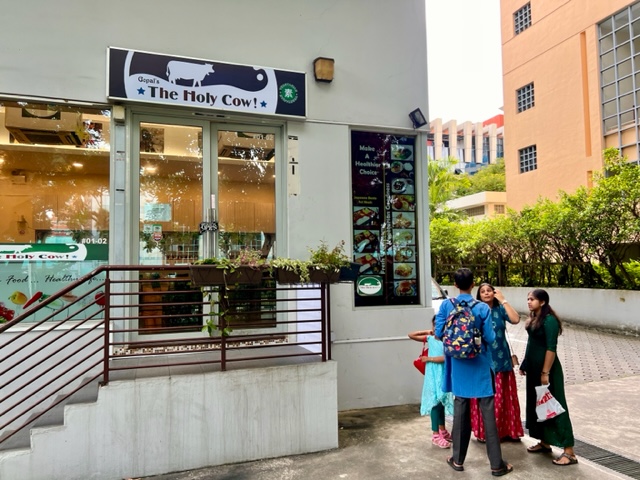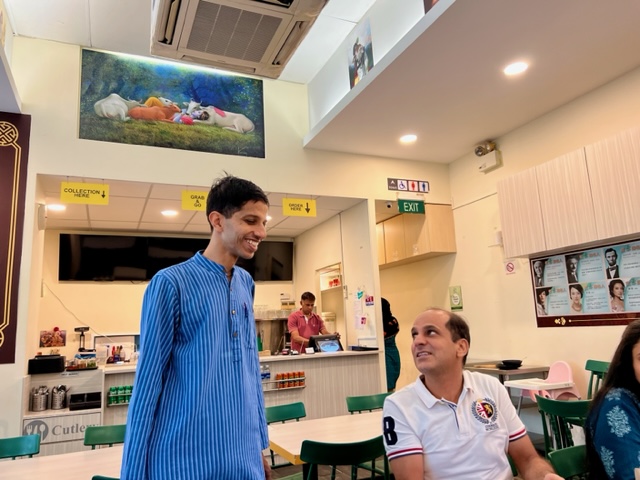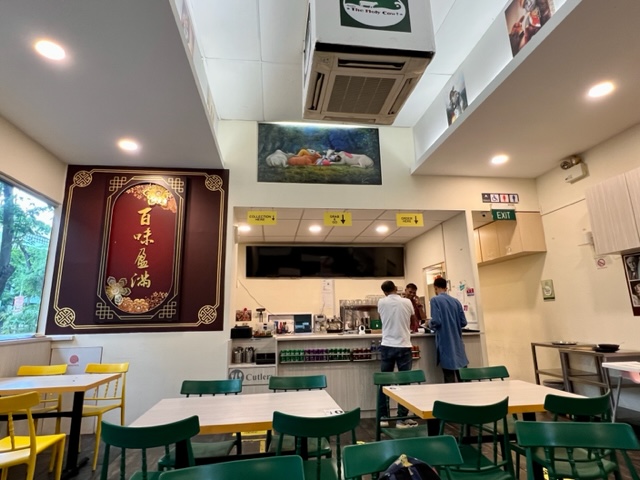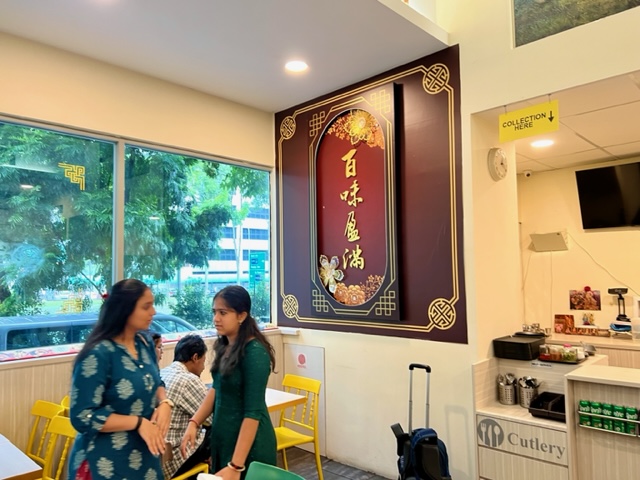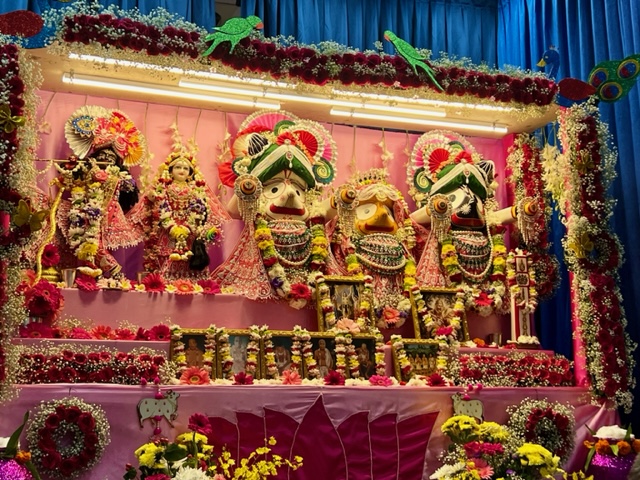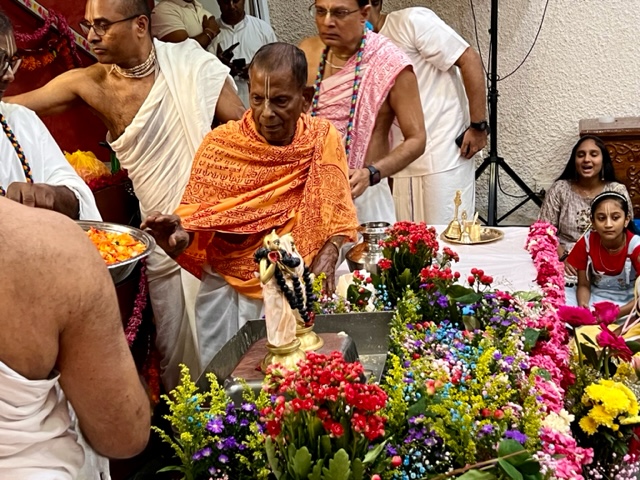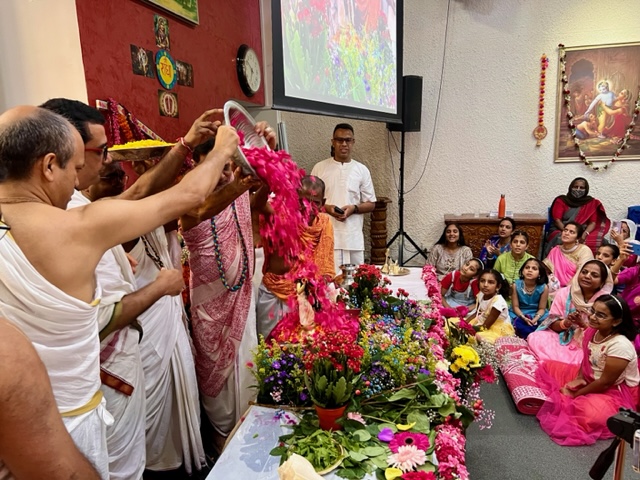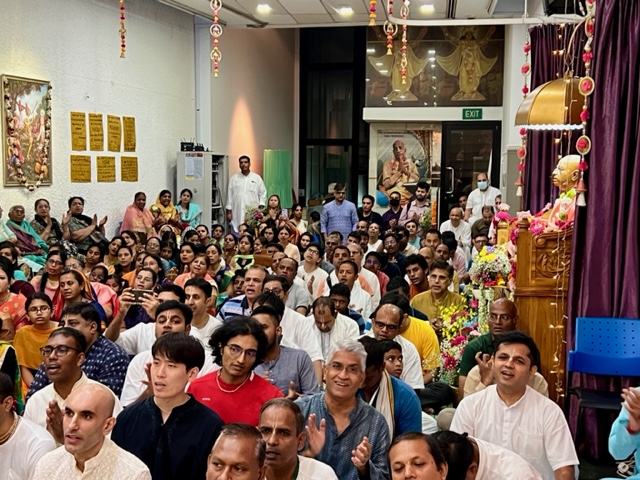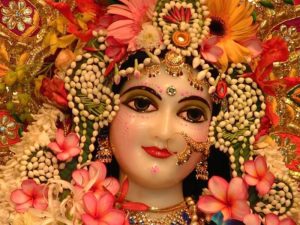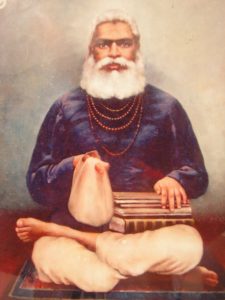 Today we have gathered for the most auspicious celebration of the appearance day of Srila Bhaktivinoda Thakura. Srila Bhaktivinoda Thakura was one of the most prominent acharyas in the disciplic succession after Lord Chaitanya, and his contribution to Gaudiya Vaishnavism and to the world is so great that one devotee called him the Seventh Gosvami. Much of the present Krishna consciousness movement founded by Srila Prabhupada is being conducted under the guidance of Srila Bhaktivinoda Thakura, and today I will focus on some of the areas in which the International Society for Krishna Consciousness is continuing his work and mission.
Today we have gathered for the most auspicious celebration of the appearance day of Srila Bhaktivinoda Thakura. Srila Bhaktivinoda Thakura was one of the most prominent acharyas in the disciplic succession after Lord Chaitanya, and his contribution to Gaudiya Vaishnavism and to the world is so great that one devotee called him the Seventh Gosvami. Much of the present Krishna consciousness movement founded by Srila Prabhupada is being conducted under the guidance of Srila Bhaktivinoda Thakura, and today I will focus on some of the areas in which the International Society for Krishna Consciousness is continuing his work and mission.
Srila Bhaktivinoda Thakura was born in an aristocratic, devotional family, but throughout his life he was afflicted by various illnesses. So we shouldn’t think that he had an easy life or that everything just came to him; the tremendous contribution he made was in the face of physically trying conditions. Of course, in a way, it did all come naturally, but he had to face many obstacles, even in terms of his physical health. In this year’s Vyasa-puja book His Grace Kalakantha dasa wrote an offering in which he listed different trials that Srila Prabhupada faced, and he suggested that Prabhupada actually suffered. It wasn’t just an appearance of difficulties; he actually suffered. But in spite of the difficulties, he continued. And that is a lesson for all of us. We shouldn’t expect that things will always come easily or go smoothly, and in spite of the difficulties and miseries, we should persevere in our efforts in Krishna consciousness.
Srila Bhaktivinoda was appointed to a government position—assistant magistrate—that was practically the highest position that any Indian held during the British rule. The British had the idea to inculcate in the Indians the idea that Indian culture was inferior to British or Western or Christian culture. In general, they kept the Indians down, but Srila Bhaktivinoda was so qualified and so popular that they were obliged to appoint him to a high position.
Srila Bhaktivinoda Thakura was a grihastha with ten children. But even with all his heavy responsibilities in his government service and as a family man, he still did so much direct service to the cause of Krishna consciousness. He utilized his time expertly. After coming home from work, he would have a light meal and take rest at about eight o’clock, and then he would get up at midnight and write books. He wrote over one hundred books and songs, and he made so many contributions. From this we can learn how we too can engage in direct service to the cause of Krishna consciousness, even with our many responsibilities of family and work, by efficiently and enthusiastically using our time—every moment possible—for devotional service.
As a magistrate, Srila Bhaktivinoda Thakura was very efficient and would dispose of many cases in short order. Judges are also judged—by how many cases they dispose of and how many of their cases are appealed and how many of their cases are overturned. Srila Bhaktivinoda Thakura had the most outstanding record of any judge or magistrate. He disposed of so many cases so quickly, and people were satisfied with his judgments, and so his decisions were not appealed or overturned.
One famous case involved a yogi who falsely claimed to be an incarnation of Vishnu, or Krishna. He would have an imitation rasa-lila every night, and people were sending their wives and daughters to dance with him. But some more intelligent or sober persons complained to the British government, and the administration, knowing Kedarnath Datta, as Bhaktivinoda Thakura was known, to be a religious man and also the deputy magistrate, assigned the case to him.
In plain dress and accompanied by some police constables, Srila Bhaktivinoda went to the village where the yogi was engaging in his nefarious activities. “You are a great yogi,” he told the man. “Why are you in this remote rural area? Why don’t you go to Jagannatha Puri and see Lord Jagannatha and be happy?” When the yogi heard these words, his offensive mentality came out and he said, “Oh, Jagannatha? That is just wood. I myself am the Supreme Lord, Vishnu!”
From the yogi’s comment, Bhaktivinoda Thakura could conclude beyond any doubt that he was a pretender, and so Bhaktivinoda had him arrested and brought to trial. Srila Prabhupada remarked, not specifically in relation to Srila Bhaktivinoda Thakura but in a more general sense, that the government should oversee the activities of sadhus and people who take the position of guru—that the government should license them. Just like nowadays you can’t just call yourself a doctor and begin to practice medicine; you have to take a course of study and be licensed to practice. If you are going to entrust your body, your medical care, to a doctor, you want to go to a doctor who is licensed. And the body is not as important as the soul. So Srila Prabhupada said that if people entrust their whole lives, their spiritual lives, to some spiritual teacher, the teacher should be tested according to certain standards, which are given in scripture. And if he doesn’t meet the qualifications, he should be declared disqualified.
So, this yogi, Bishkishan, was creating a disturbance with his immoral, illicit activities, and thus Bhaktivinoda Thakura ordered him arrested. This is also interesting, because Indian culture is so advanced and evolved that even the demons and rascals can be cultured and knowledgeable. In diplomatic behavior, one first tries reason and logic, good argument, and if that fails, one tries bribery. So, the yogi told Bhaktivinoda Thakura, “If you cooperate with me, I will give you great powers and you will become the king of India.” But that didn’t work, so Bhaktivinoda Thakura had him apprehended and taken to Puri.
The yogi threatened Srila Bhaktivinoda and all the people associated with him: “If you do this, I will cause you all to become sick, and you will all die.” And the yogi actually did have powers, and Bhaktivinoda Thakura and his family members all became extremely ill. They had very high fevers, and it looked like they could die. Bhaktivinoda Thakura’s wife appealed to him, “Please let the yogi go. It is not worth the cost of our lives to bring the yogi to justice.” But Bhaktivinoda Thakura replied, “No, let us all die, but this rascal must be punished.”
Eventually the day of the trial came, and Bhaktivinoda Thakura understood that the yogi had conserved his mystic powers in his hair, which Srila Prabhupada said was not entirely uncommon. There is the biblical story of Samson and Delilah: Samson was very powerful, but when his hair was cut he lost his power. Some of the modern yogis also have power in their hair. So, when the trial began, Bhaktivinoda Thakura ordered, “Bring a barber to cut his hair.” But no barber dared. The yogi did have mystic powers, and he made threats, and sparks actually came out of his hair, but Bhaktivinoda Thakura personally took the scissors and cut it, and he sentenced the yogi to six months in jail. There, the yogi wrote a note admitting that he had been an imposter, and he managed to get some poison and took his own life. Srila Bhaktivinoda Thakura was so fearless, so courageous, so determined.
Although Bhaktivinoda Thakura was posted in Orissa and was also the superintendent of the Jagannatha temple, his heart hankered to be closer to the birthplace of Sri Chaitanya Mahaprabhu. He wanted to be posted in Nadia, but he was rendering such valuable service in the government that they didn’t want to let him go; they didn’t want to grant him a transfer. But his desire was so strong that even though he did have such a responsible and prestigious position and a big family to maintain, eventually he said, “If you don’t transfer me, I am going to give up government service and retire and just go.” So, then they posted him in Krishna Nagar, which is near Navadvipa.
From there, Bhaktivinoda Thakura sought to ascertain the birthplace of Sri Chaitanya Mahaprabhu. Over time, the Ganges River had changed its course and the landscape, the terrain, had changed, so there was a question as to the birthplace’s location. Bhaktivinoda Thakura studied maps and consulted local people, and eventually he had a vision of a mound of earth out of which tulasis were growing. And when he went to the place that he believed was the birthplace, the local people confirmed that it was, as did his siksa-guru, Srila Jagannatha dasa Babaji Maharaja.
Bhaktivinoda Thakura built a bhajana-kutira in Godrumadvipa at Surabhi-kunja, where four hundred years earlier Lord Nityananda had established the nama-hatta. And he revived the nama-hatta and turned it into a powerful preaching movement in Bengal especially. It was also later revived by Srila Prabhupada and his followers, notably Sripada Jayapataka Swami Maharaja, who spread the nama-hatta in Bengal and Orissa and all over the world.
Srila Bhaktivinoda built a house near Surabhi-kunja, overlooking the Jalangi River. Devotees go there on parikrama when they go to Navadvipa. You can see his bedroom—his chair, his table, his bed. Next to it is another room, where his son Srila Bhaktisiddhanta Sarasvati Thakura would sometimes stay. And there is the bhajana-kutira of his disciple, Srila Gaurakisora dasa Babaji Maharaja. It is a very sacred place.
There’s a balcony where Srila Bhaktivinoda would chant japa, and one day he was looking across the river from the balcony and had a vision of a wonderful temple and a whole community of devotees engaged in the service of Lord Chaitanya—a whole city. This temple, adbhuta mandira, was mentioned by Locana dasa Thakura in one of his books, that Lord Nityananda had predicted that there would be an astounding temple rising up in Mayapur, with a whole community of devotees engaged in the service of the Lord.
Srila Bhaktivinoda wanted to build a temple at the birthplace, and he personally took up a collection. He was such a prestigious person, but he went door-to-door, begging people to contribute whatever they could for the construction of the temple. And one of the main newspapers in Calcutta, the Amrita Bazar Patrika, appealed to the citizens that the noble Bhaktivinoda Thakura would be coming and everyone should contribute to the worthy cause. Srila Prabhupada knew Tarun Kanti Gosh and his father, Tushar Kanti Gosh, a prominent Bengali intellectual who published the paper. And Tushar’s father, Shishir Kumar Ghosh, called Bhaktivinoda Thakura the Seventh Gosvami.
So, Srila Bhaktivinoda was so humble that he went door-to-door, and he raised a collection and built the original temple of Lord Chaitanya at His birthplace in Mayapur. As for a whole community of devotees, Srila Bhaktivinoda’s son and, in a way, disciple, Srila Bhaktisiddhanta Sarasvati Thakura, took up that project. He made a beginning, and you can see some cottages in Mayapur; a few of his disciples built cottages. He himself established the Gaudiya Matha there with brahmacharis and sannyasis.
This project also came through the disciplic succession to Srila Prabhupada, and he really wanted to develop the Mayapur city. Certainly, more has been done to establish the city than ever before, and it is growing, taking shape. Srila Prabhupada also wanted to build a magnificent temple for Sri Chaitanya Mahaprabhu, for the Pancha-tattva, in Mayapur.
One year, I was serving in the Calcutta temple and Srila Prabhupada arrived from London and was so enthusiastic about the Mayapur project, the big temple, that in London he had actually drawn a design for what the temple—the first building—would look like. When he arrived in Calcutta, he was so enthusiastic that he pulled out the blueprints and was showing everyone. He had worked on them with our godbrother Nara Narayan Prabhu. He was so enthusiastic, so excited, and that enthusiasm spread to us.
But then Srila Prabhupada did something very interesting and instructive. He called a meeting with the senior devotees, and right when everyone was at the peak of their enthusiasm for the project, he raised the question of the flooding in Mayapur, because quite frequently during the rainy season the Ganges floods and the area is submerged under water. He was saying that if we built the city there, built the temple there, they could be flooded, and the whole thing could be lost. He questioned whether we should even build the temple and try to establish the city there. Of course, he was Srila Prabhupada—he had so much authority—and on top of that, his logic and his intelligence were so powerful. So, he took that position, and he suggested that we consider alternative locations. He suggested Birnagar, Srila Bhaktivinoda Thakura’s birthplace and one of his residences, a very nice place in Bengal with a very nice atmosphere. So, we were swayed, convinced—but then he brought up Mayapur again, and in the end he concluded that we should go ahead and do it in Mayapur. Even though there was a risk, we should go ahead.
The whole exercise illustrated an important principle that Srila Prabhupada often mentioned, that in whatever we do we should be careful and cautious and use our intelligence. He defined intelligence as seeing the same thing from different angles of vision, different points of view. He didn’t want us to just blindly rush forward: “Now we are going to fulfill Bhaktivinoda Thakura’s prophecy; we are going to fulfill Nityananda Prabhu’s desire.” We are in the material world, and in the material world there are many dangers—padam padam, there is danger at every step—and Prabhupada wanted us to be cautious and careful and to see things from different angles of vision, not just rush ahead based on blind faith or enthusiasm.
Then, at the end of the discussion, Prabhupada said, “If you all build this temple for Sri Chaitanya Mahaprabhu, Srila Bhaktivinoda Thakura will personally come and take you all back to Godhead.” Bhaktivinoda Thakura has that power. In fact, before we end we will sing a song by him, Ohe! Vaisnava Thakura, in which he prays to the Vaishnava, “Krishna is yours, and you can give Him to me, for such is your power. So I am running behind you, crying out, ‘Krishna! Krishna!’ ” That is the truth: The Vaishnava possesses Krishna. Krishna comes under the control of the love of the pure devotee, and if the pure devotee is pleased with our service, he can deliver Krishna to us. And that is really how we progress. Yes, we have to make our effort, but ultimately our success depends on the mercy of higher authorities. If we please them by our sincere efforts to serve and follow their instructions, if they are satisfied, they can deliver Krishna to us. So, we should submit ourselves at their lotus feet, roll in the dust of their lotus feet, and beg them for their mercy. We have no other hope. Our effort isn’t really what brings success. Our effort is there because we have to make our effort; it is our duty.
I read in His Holiness Radhanath Swami’s memoir, The Journey Home, that Maharaja was once spending the night with Ramesh Baba in Varsana when there was news that a man-eating leopard was on the prowl and that it had already massacred some cows and villagers. In those days, Varsana—the whole area of Vraja—was much less built up than it is now. Srila Prabhupada’s friend Bhagatji, who had a house near the Krishna-Balarama temple, said that when he had moved to Vrindavan, in the 1930s or so, the forest was so thick that he could walk from Raman Reti to Govardhana Hill in the middle of the day and never see the light of the sun. That was just forty years before Prabhupada began the Krishna-Balarama temple.
So, Ramesh Baba was taking rest outside Mana-ghata, and with the leopard nearby, Radhanath Swami thought, “If he is going to stay there, I will stay there with him.” So, he lay down, and Ramesh Baba had a wooden stick by his side. When Radhanath Swami asked about it, Ramesh Baba said, “Yes, there is a leopard on the prowl.” Radhanath Swami asked, “What will that small stick do to protect us from a wild leopard?” “Nothing,” Ramesh Babaji replied. “Only the Lord can protect us. Our duty, however, is to show Krishna that we are doing our part.”
The same principle applies to all of our devotional practices. We have to show that we are making the effort, but without mercy we have no ability to move forward even one inch in devotional service. Of course, the more effort we put in, you could say, the more result we will get, because we are showing how sincere and eager we are. But it is really the mercy of the acharyas and the Supreme Personality of Godhead that enables us to move forward even one iota. Bhaktivinoda Thakura was in that mood. Every acharya is in that mood, because that’s how they get the mercy and strength to practice and preach Krishna consciousness. And that’s how we have this song, Ohe! Vaisnava Thakura.
Srila Prabhupada demonstrated this principle in a unique way in a very special context. When I was in Madras—I was the first devotee from ISKCON to go there to preach—I was meeting various prominent people, and many of them were interested, but one who took very keen interest was the chief justice of the high court, Justice Veeraswami. Toward the end of Prabhupada’s visit to Madras, after a successful five-day program, Justice Veeraswami arranged a pandal program for Srila Prabhupada and the devotees. And he invited all the other high court judges and high court advocates to attend.
In his talk Srila Prabhupada quoted the verse from Sad-gosvamy-astaka about the Six Gosvamis: tyaktva turnam asesa-mandala-pati-srenim sada tuccha-vat, that although they had been very highly placed people (mandala-pati) they had rejected it all as insignificant (tuccha-vat) and joined the mission of Sri Chaitanya Mahaprabhu. Srila Prabhupada was appealing to these leaders, these high court judges and advocates, that they too should give up their prestigious positions and join Lord Chaitanya’s mission.
After the program, the chief justice invited Srila Prabhupada and the devotees to his home for prasada, and there he presented Srila Prabhupada a beautiful, small silver statue of Krishna. Amongst all the adult devotees there was one child, Saraswati, the three-year-old daughter of Shyamsundar and Malati, and Srila Prabhupada engaged her in a very dramatic way. He held the little statue of Krishna in front of her and said, “Saraswati, who is this?” And Saraswati said, “It is Krishna.” Then he held the deity behind his back and said, “Saraswati, where is Krishna?” Saraswati started looking everywhere, and when she couldn’t find the deity, she became filled with anxiety: “Where is Krishna? Where is Krishna?”
Then Malati said, “Saraswati, who has Krishna?” And Saraswati’s eyes opened wide and her face lit up and she said, “Prabhupada has Krishna!” And then she looked at Prabhupada with such joy and expectation and ran up to him, and Prabhupada brought the deity of Krishna out from behind his back and gave it to her.
I thought, “Wow!” Prabhupada had illustrated such a profound truth. It was like Srila Bhaktivinoda Thakura: “You have Krishna, and you have the power to deliver Him to us.” But to get Krishna from a Vaishnava, to get love of Krishna, we have to be eager like Saraswati. She was so eager to find Krishna and so anxious without Him: “Where is Krishna? Where is Krishna?” Prabhupada quoted that last verse of the Sad-gosvamy-astaka: he radhe vraja-devike ca lalite he nanda-suno kutah, sri-govardhana-kalpa-padapa-tale kalindi-vanye kutah/ ghosantav iti sarvato vraja-pure khedair maha-vihvalau, vande rupa-sanatanau raghu-yugau sri-jiva-gopalakau, that the Six Gosvamis were wandering all over Vrindavan, crying, “O Krishna, O Radharani, O Lalita—where are you? Are you at Govardhana Hill or are you at the banks of the Yamuna?” These were their moods in executing Krishna consciousness. When we have that eagerness and intense longing and desire in separation, Krishna, by the mercy of the devotee or devotees, will gradually manifest Himself to us. But we have to have that eagerness. And that eagerness arises when we become purified, and we become purified by making a concerted effort.
I had a dream a couple of years ago in which Srila Prabhupada told me, “You have to be mad for Krishna.” It was a nice dream. Shortly thereafter, Radhanath Swami came to stay with me and I mentioned the dream to him, and when I said that—“mad for Krishna”—he said, “Oh, that’s a very advanced stage.” So that is not something to be taken lightly, but it should be our goal, and we approach that goal by making strenuous, unstinting effort, not holding anything back, not like, “So much for Krishna and so much for me,” but, “Everything for Krishna and nothing for me”—in that mood. Of course, we have to keep our body and soul together—that’s also one of Srila Bhaktivinoda Thakura’s instructions. But yes, our goal is kirtaniyah sada harih, to always chant the holy name of Krishna.
Srila Bhaktivinoda Thakura raises a question: “What about maintaining our body, or our families’ bodies?” He says that taking care of the body, or taking measures necessary to maintain the body, which also includes working, earning money, and spending money, does not violate the principle of kirtaniyah sada harih, always chanting the holy name of Krishna, if we do it just enough to meet our requirements so that we can use all our other time for Krishna kirtan.
So, he was also very practical. So many instructions, so many wonderful books. Hari-nama-cintamani is a small book about chanting the holy name; Jaiva-dharma; Sri Caitanya-siksamrta is so full of valuable instructions.
In Jaiva-dharma Srila Bhaktivinoda Thakura discusses kanistha, madhyama, and uttama devotees. Of course, all of our acharyas follow the Bhagavad-gita and Srimad-Bhagavatam; they are the basic authorities. The Bhagavatam says in relation to the madhyama-bhagavata: prema-maitri-krpopeksa, yah karoti sa madhyamah, that he gives his love to Krishna, makes friendship with devotees, is merciful to the innocent, and neglects (upeksa) the envious. Almost everyone in the material world is envious of Krishna. Unless you are a pure devotee, you have some envy of Krishna. But there are people who are really envious. They don’t want to hear about Krishna, and if you are pursuing Krishna consciousness, they discourage you. They may try to put up obstacles; they might try to convince you—so many things, sometimes even our own family members.
So, Srila Bhaktivinoda Thakura discusses this neglect, avoiding the association, of nondevotees: asat-sanga-tyaga,—ei vaisnava-acara, ’stri-sangi’—eka asadhu, ‘krsnabhakta’ ara. Chaitanya Mahaprabhu says asat. Sat is a word for “devotee,” so asat means “nondevotees.” Asat-sanga-tyaga: we should give up the association of nondevotees. And who are nondevotees? ’Stri-sangi’—eka asadhu. One is a person who is attached to sense gratification, especially to the opposite sex for sense gratification. And ’Stri-sangi’—eka asadhu, ‘krsnabhakta’ ara: the other is just an abhakta, someone who is not a devotee of Krishna. So, we are supposed to shun the association of nondevotees, but what do we do if we have family members who are nondevotees? What do we do if we are in a place with nondevotees, or work with them? Srila Bhaktivinoda Thakura answers that avoiding the association of nondevotees does not mean that we cannot have normal human interaction with them as is expected in the workplace or in family; it means that we should not associate with them in relation to our spiritual advancement. We shouldn’t take their advice in relation to our spiritual progress.
In the Seventh Canto of Srimad-Bhagavatam, Narada’s instructions on the ideal family life, Narada says the same thing, that if you are a devotee and a family member tells you that you should lead a different kind of life, outwardly you should say, “Yes, what you say is very good,” but inwardly you should continue in your own determination and keep your life simple.
So, Srila Bhaktivinoda Thakura says that we should not abandon family members who are not devotees. Of course, that would depend on one’s ashrama, but he says that we should not abandon them, but that for our spiritual advancement we should keep the association of only devotees.
In Hari-nama-cintamani Bhaktivinoda Thakura first discusses the holy name in general and then discusses the ten offenses. The first offense is sadhu-ninda: blaspheming devotees. Bhaktivinoda Thakura is very analytical and precise, and with each of the ten offenses he begins by defining the terms. So, sadhu-ninda. Ninda is easy. Ninda means “to criticize,” “to blaspheme,” “to find fault.” But sadhu—who is a sadhu? Bhaktivinoda Thakura discusses the different qualities of a sadhu mentioned by Krishna in the Eleventh Canto, and one is krsnaika-sarana: he has taken exclusive shelter of Krishna. Srila Krishnadasa Kaviraja Gosvami also lists twenty-six qualities of a devotee, based mainly on those mentioned in the Eleventh Canto, and out of the twenty-six qualities, one is krsnaika-sarana, taking exclusive shelter of Krishna, or the holy name of Krishna. Srila Bhaktivinoda Thakura says that if one has that primary qualification, he or she is considered a sadhu even if he or she does not have the other twenty-five qualities. And if one has the other twenty-five qualities but does not have the qualification of having taken exclusive shelter of Krishna, the other twenty-five qualities are of little value. So that—taking exclusive shelter of Krishna—is the real qualification for a sadhu, and if someone has that, he or she is a sadhu.
Then Srila Bhaktivinoda Thakura discusses possible grounds for criticizing a sadhu. One may say, “Okay, this is a sadhu; this person has taken shelter of Krishna,” but criticize the person because he has taken a low birth or is of a lower caste or had previously engaged in sinful activities or still has vestiges of sinful activities even after coming to the association of devotees. One might think one can criticize like that. But Bhaktivinoda Thakura says no, these are all sadhu-ninda. So, we have to be careful about this, because our spiritual advancement depends on the association of sadhus and our practical service to the mission depends on their cooperative effort. If we blaspheme, find fault, backbite, we will destroy our devotional service.
Bhaktivinoda Thakura then discusses people who could be considered sadhus but who actually are not sadhus, because we don’t want to mistake a sadhu for an asadhu. Sometimes people will say, “You are not a devotee. Devotees are humble. You are not humble, so you are not a devotee.” But Bhaktivinoda Thakura says that if you are surrendered to Krishna, even if you don’t have the other twenty-five qualifications, such as humility, you are still considered a sadhu. Sadhur eva sa mantavyah.
But we also don’t want to mistake an asadhu for a sadhu. Bhaktivinoda Thakura mentions three categories of asadhus who are often mistaken for sadhus. One is the Mayavadi. Although Mayavadis may dress as sadhus and be considered by others as sadhus, they are not actually sadhus. Another category is the atheist. And the third category is dharmadvaji. Dharma means “religion” and dvaja means “flag.” So dharmadvaji means a pretender, someone who is waving the flag of religion but is not really a devotee.
These are three categories of asadhus, nondevotees who are sometimes mistaken as sadhus. Srila Prabhupada regularly criticized people who were revered as spiritual leaders in India. “Perhaps for the first time,” he said, “I am the only one who is exposing them as fools and rascals.” A very heavy statement. Many people became upset with him when he criticized India’s revered, popular, “religious” figures.
There was one man in Juhu who had attended the first Bombay pandal where Prabhupada had criticized Shankaracharya. He was very intelligent and austere and well read, and years later he told me, “I was attending that pandal program, and when Prabhupada criticized Shankaracharya, I thought, ‘Who does this man think he is? Shankaracharya is perhaps the greatest acharya in the history of India. Who does this person think he is to criticize him?’ ” So, he had negative thoughts about Srila Prabhupada, but later he got one of Srila Prabhupada’s books, either Teachings of Lord Caitanya or Caitanya-caritamrta, in which Prabhupada relates the history of Lord Shiva coming as Shankaracharya to bewilder the atheists by preaching Mayavada philosophy. The man read it and came to me and said, “After reading this book, I realized that everything that Prabhupada was saying was true.” And then he surrendered; he became a devotee.
Another incident involved Srila Prabhupada’s regular companion on his morning walks on Juhu Beach, Dr. C. P. Patel. One morning in particular Dr. Patel praised some famous, popular, Indian religious figure. When Srila Prabhupada said, “He is a rascal,” Dr. Patel got upset: “How can you say he is a rascal?” Prabhupada said, “I am not saying; Krishna is saying: na mam duskrtino mudhah, prapadyante naradhamah. It is a simple test. Is he surrendered to Krishna or not? If he is not surrendered to Krishna, he is a rascal, he is a fool, he is a demon. I am not saying; Krishna is saying.”
Dr. Patel got really upset; Prabhupada had picked on someone he cherished. So, he raised his voice, and Prabhupada raised his voice, and then he raised his voice more, and Prabhupada raised his voice more, and finally they were literally shouting at each other. It was scary, actually. Dr. Patel’s cronies tried to restrain him, saying, “Swamiji has a heart condition. Don’t upset him so.” They were physically . . . it was like in a boxing ring: the bell rings, signaling that the round is over, but the fighters are still pounding each other, and the referee and their trainers are trying to pull them apart. They wouldn’t stop. Then finally Dr. Patel’s people pulled him away.
After that, for the first time in years, Dr. Patel stopped coming on Srila Prabhupada’s walks. For years he had come to Prabhupada’s room and escorted him in his car or walked with him to the beach or at least met up with him at the beach. But after the argument, he didn’t come. Prabhupada also said, “All right, from now on no discussion. We will only read the Krsna book on morning walks.” So, we would read the Krsna book. And Dr. Patel was avoiding us.
Then one morning, Prabhupada was walking in one direction, toward the ocean, and Dr. Patel was walking in the opposite direction, away from the ocean. And the way Dr. Patel described it, something in his heart just made him change direction and walk straight to Srila Prabhupada. He bowed and touched Srila Prabhupada’s lotus feet and said, “Prabhupada, I am sorry, but we have been trained to respect all the accredited saints of India.” And Prabhupada replied, “Our business is to point out who is not a saint.” Acharyas have to do that, but it is not ninda. It can be, but it is not ninda if it is done to help people who could be misled by a demon or rascal, to keep them from falling into bad association thinking that they are getting the association of a saintly person.
But otherwise, ninda sunya. Rupa Gosvami says that one should take shelter of a Vaishnava whose heart is completely free from the propensity to criticize others. A pure devotee wants only to chant the holy name and hear about Krishna and preach the message of Krishna. He has no interest in criticizing others, even nondevotees, demons, but for the sake of preaching, for the sake of Krishna’s mission, Mahaprabhu’s mission, the previous acharyas’ mission, they do it to help others, to free them from false attachments so they can take to Krishna consciousness. Or even if they are in Krishna consciousness, to prevent them from unknowingly falling into bad association and being diverted. So, that’s the mercy of the acharya, the sadhu, the preacher, but otherwise they have no interest in criticizing anyone or anything. They are happy just to chant and hear about Krishna.
So, today is a most auspicious day. Our system is parampara. We approach our immediate spiritual master and serve him, and through him we serve the predecessor acharyas. But on special days like today, on appearance days and disappearance days, by the mercy of our spiritual master we can approach the previous acharyas directly, like when we offer them puspanjali. And we can beg them, “Please give me your mercy. Please give me some of what you have, which I want desperately, and even if I don’t have the desire, the desire is not very strong, please give me the desire and make my desire stronger.” Wherever we are on that path of desire, we can pray to get the desire, to increase the desire. Because it all depends on desire—everything depends on desire. Krishna fulfills all desires, and if what we really desire is Krishna and Krishna’s service, that is what He will fulfill.
The way we show our desire is by making the effort, by spending the time. If we spend the time chanting, trying to chant with attention, even if we aren’t even able to pay attention that well and our mind is still unsteady or distracted, if we just take the time to make the effort, Krishna will see, “Oh, this person is taking the time to try to develop his relationship with Me.” Or reading Srila Prabhupada’s books—even if we don’t understand exactly what we are reading, even if we can’t appreciate it or relate to it, if we just spend the time reading, trying to understand, hoping to come to appreciate, then Krishna, the previous acharyas, will say, “Oh, this person is spending the time.” It is association. Chanting means associating with Krishna; reading Srimad-Bhagavatam means associating with Krishna. “This person wants My association. He is taking the time to be with Me.” And Krishna will reciprocate.
We just have to show Krishna that we want to develop a relationship with Him. We are not qualified. By His mercy He will give us the qualification, but our part at first is just to show Him that we want to develop our relationship with Him by spending time with Him. To develop a relationship with someone, you have to spend time with the person. So, chanting with attention, reading Prabhupada’s books, worshipping the Deity, sraddhaya, with faith and veneration, not just mechanically, externally—spending time with Krishna. When Krishna sees that we want to spend time with Him, develop our relationship with Him, He will help us. We just have to spend the time and make the effort.
Srila Prabhupada was holding Krishna for Saraswati. He actually wanted to give Him to her, but he could do so properly only when she was sufficiently anxious, sufficiently eager, when her desire was strong enough that she would really appreciate it. Srila Prabhupada and our other acharyas have Krishna—they want to give Him to us, and they have the power to give Him to us—but they don’t want to cast pearls before swine. They want us to value what they have to give us, and when we understand what that most valuable treasure is and really want it, and when we take the time to develop our relationship with Krishna and they see that it, and nothing else, is really what we want, they will fulfill our desire—by their mercy. If that’s what we want, if Krishna and Krishna’s service is all we want, we will get it by their mercy.
Hare Krishna.
I’ve requested Mukunda Datta Prabhu to lead that song, Ohe! Vaisnava Thakura, in which Bhaktivinoda Thakura expresses the mood that we all want to develop; and, like offering a drop of Ganges water to the Ganges, we can offer that mood, in his words, to him so that he will give us a drop of faith in the holy name.
Ohe! Vaisnava Thakura
(from Saranagati)
ohe!
vaisnaba thakura, doyara sagara,
e dase koruna kori’
diya pada-chaya, sodho he amaya,
tomara carana dhori
O venerable Vaisnava, O ocean of mercy, be merciful unto your servant. Give me the shade of your lotus feet and purify me. I hold on to your lotus feet.
chaya bega domi’, chaya dosa sodhi’,
chaya guna deho’ dase
chaya sat-sanga, deho’ he amare,
boshechi sangera ase
Teach me to control my six urges; rectify my six faults, bestow upon me the six qualities, and offer unto me the six kinds of holy association.*
ekaki amara, nahi paya bala,
hari-nama-sankirtane
tumi krpa kori’, sraddha-bindu diya,
deho’ krsna-nama-dhane
I do not find the strength to carry on alone the sankirtana of the holy name of Hari. Please bless me by giving me just one drop of faith with which to obtain the great treasure of the holy name of Krishna.
krsna se tomara, krsna dite paro,
tomara sakati ache
ami to’ kangala, ‘krsna’ ‘krsna’ boli’,
dhai tava pache pache
Krishna is yours; you have the power to give Him to me. I am simply running behind you shouting, “Krishna! Krishna!”
*The six urges are those of speech, the mind, anger, the tongue, the belly, and the genitals. The six faults are overeating, overendeavoring for material objectives, talking unnecessarily of mundane affairs, being too attached to or too neglectful of scriptural rules and regulations, associating with worldly-minded persons, and desiring mundane achievements. The six good qualities are enthusiasm, confidence, and patience, and performing the regulated activities of devotional service, giving up the association of nondevotees, and following in the footsteps of the previous acharyas. The six methods of holy association are offering gifts in charity, accepting charitable gifts, revealing one’s mind in confidence, inquiring confidentially, accepting prasada from devotees, and offering prasada to devotees.
[A talk by Giriraj Swami on Bhaktivinoda Thakura’s appearance day, September 1, 2009, New Dvaraka, Los Angeles]
 By The Sastric Advisory Council
By The Sastric Advisory Council
